Stan C. Smith's Blog, page 34
November 12, 2017
Awesome Animal - Dragonfly
Have you read my novel
Profusion
? In two recent posts, I featured two awesome animals (the no-see-um and the sailfish) that Bobby uses to try to stop a planet-threatening outbreak of creatures. Well, Bobby's plan also involves one more awesome animal, the
dragonfly
. He chooses the dragonfly because he knows it is one of the fastest flying insects. So the dragonfly is today's awesome animal.
So why all the fuss about dragonflies?
As you probably know, dragonflies are insects. They are in an insect order called Odonata. There are a whopping 7,000 living species of dragonflies that we know of. And many more existed in the past. Actually, to be honest, for an order of insects, 7,000 really isn't that many. The order, Coleoptera, which is the beetles, has about 400,000 different species!
Dragonflies are predators. They dart around at high speeds snarfing up smaller insects like flies and mosquitoes. When Trish and I are on our annual canoeing trip to the Boundary Waters of northern Minnesota, we love having dragonflies buzzing around us, because we know they are eating the mosquitoes. And northern Minnesota has a lot of mosquitoes.
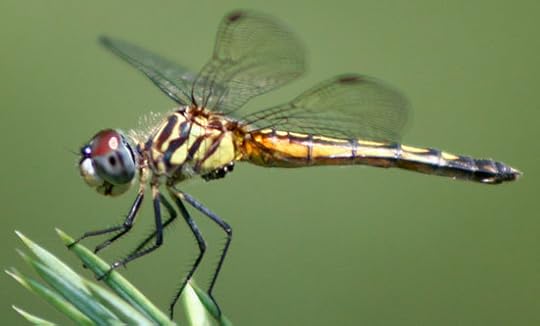
Amazing facts about Dragonflies
Dragonflies have been around for a long time! An extinct order of insects called Meganisoptera are thought to be dragonfly ancesters, and there are fossils of them that are 325 million years old. These ancient creatures were the largest insects to have ever lived, as far as we know. Some of them had wingspans of almost 30 inches (75 cm). Check out this reconstruction of one:

Dragonflies are amazing fliers. They have four wings, with attached muscles that allow them to control each wing separately. This allows them to not only hover in place but also to fly in any direction--up, down, sideways, even backward.
They are not only agile flyers, they are crazy-fast. Some of them can fly 18 miles per hour (29 kph). That may not seem really fast to us but think about their size. If a dragonfly were my size (5' 11"), that would be the equivalent of 324 miles per hour!
Because of their speed and agility, they are astoundingly good hunters. Dragonflies fly around like skilled fighter pilots, snatching small insects on the wing. Their highly-adapted eyes and nervous system allow them to adjust the speed, angle, and distance of flying prey and intercept them in midair. While hunting, they have up to a 95% success rate.
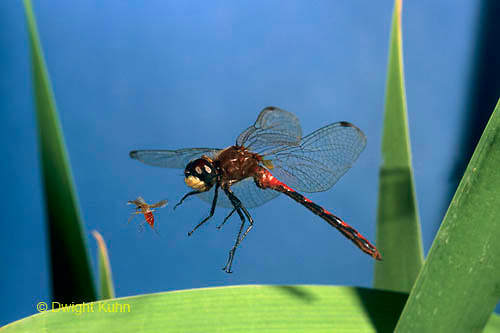
Here's an excerpt from a New York Times article:
One research team has determined that the nervous system of a dragonfly displays an almost human capacity for selective attention, able to focus on a single prey as it flies amid a cloud of similarly fluttering insects, just as a guest at a party can attend to a friend’s words while ignoring the background chatter.
Check out this amazing BBC video on the highly advanced visual and nervous system of dragonflies.
Dragonflies have incredible eyes! If you look closely at a dragonfly's head, you'll see it is mostly just eyes. That's because their eyes are made up of more than 30,000 facets (tiny individual light sensors). Because of the spherical shape of their eyes, they can see almost 360 degrees of their surroundings, except for a small blind spot directly behind them. These huge eyes are a major factor in their ability to catch prey as effectively as they do.

And finally... even baby dragonflies are fierce predators. Most of a dragonfly's life is actually spent as a nymph, living underwater (as long as five years in some of the larger species). And these nymphs are awesome predators in their own right. They feed on aquatic insects (like mosquito larvae), and even larger things like tadpoles and small fish!
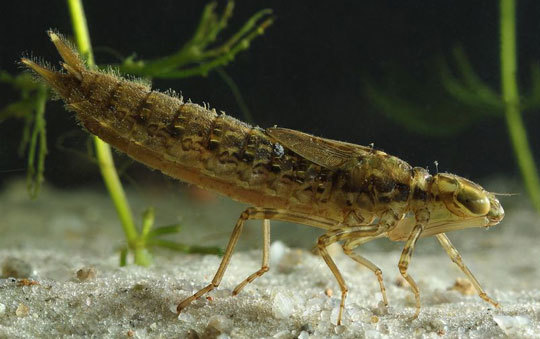
So, the Dragonfly deserves a place in the B.A.H.O.F. (Bodacious Animal Hall of Fame).
FUN FACT: Bodacious originated in the 1800s. At that time it meant something like complete or thorough. But in the 1970s it caught on in American slang. In the 1990s it came to also mean sexually attractive. But in this instance, I am simply using it as another way to say awesome (because dragonflies are only sexually attractive to other dragonflies, right?).
So why all the fuss about dragonflies?
As you probably know, dragonflies are insects. They are in an insect order called Odonata. There are a whopping 7,000 living species of dragonflies that we know of. And many more existed in the past. Actually, to be honest, for an order of insects, 7,000 really isn't that many. The order, Coleoptera, which is the beetles, has about 400,000 different species!
Dragonflies are predators. They dart around at high speeds snarfing up smaller insects like flies and mosquitoes. When Trish and I are on our annual canoeing trip to the Boundary Waters of northern Minnesota, we love having dragonflies buzzing around us, because we know they are eating the mosquitoes. And northern Minnesota has a lot of mosquitoes.

Amazing facts about Dragonflies
Dragonflies have been around for a long time! An extinct order of insects called Meganisoptera are thought to be dragonfly ancesters, and there are fossils of them that are 325 million years old. These ancient creatures were the largest insects to have ever lived, as far as we know. Some of them had wingspans of almost 30 inches (75 cm). Check out this reconstruction of one:

Dragonflies are amazing fliers. They have four wings, with attached muscles that allow them to control each wing separately. This allows them to not only hover in place but also to fly in any direction--up, down, sideways, even backward.
They are not only agile flyers, they are crazy-fast. Some of them can fly 18 miles per hour (29 kph). That may not seem really fast to us but think about their size. If a dragonfly were my size (5' 11"), that would be the equivalent of 324 miles per hour!
Because of their speed and agility, they are astoundingly good hunters. Dragonflies fly around like skilled fighter pilots, snatching small insects on the wing. Their highly-adapted eyes and nervous system allow them to adjust the speed, angle, and distance of flying prey and intercept them in midair. While hunting, they have up to a 95% success rate.

Here's an excerpt from a New York Times article:
One research team has determined that the nervous system of a dragonfly displays an almost human capacity for selective attention, able to focus on a single prey as it flies amid a cloud of similarly fluttering insects, just as a guest at a party can attend to a friend’s words while ignoring the background chatter.
Check out this amazing BBC video on the highly advanced visual and nervous system of dragonflies.
Dragonflies have incredible eyes! If you look closely at a dragonfly's head, you'll see it is mostly just eyes. That's because their eyes are made up of more than 30,000 facets (tiny individual light sensors). Because of the spherical shape of their eyes, they can see almost 360 degrees of their surroundings, except for a small blind spot directly behind them. These huge eyes are a major factor in their ability to catch prey as effectively as they do.

And finally... even baby dragonflies are fierce predators. Most of a dragonfly's life is actually spent as a nymph, living underwater (as long as five years in some of the larger species). And these nymphs are awesome predators in their own right. They feed on aquatic insects (like mosquito larvae), and even larger things like tadpoles and small fish!

So, the Dragonfly deserves a place in the B.A.H.O.F. (Bodacious Animal Hall of Fame).
FUN FACT: Bodacious originated in the 1800s. At that time it meant something like complete or thorough. But in the 1970s it caught on in American slang. In the 1990s it came to also mean sexually attractive. But in this instance, I am simply using it as another way to say awesome (because dragonflies are only sexually attractive to other dragonflies, right?).
Published on November 12, 2017 12:34
October 28, 2017
Awesome Animal - Sailfish
Have you read my novel
Profusion
? In my last bi-weekly email, I featured the no-see-um, a tiny insect that Bobby uses to try to stop a planet-threatening outbreak of terrifying creatures. Well, Bobby's plan also involves an aquatic animal, the
sailfish
. He chooses the sailfish because he knows it is one of the fastest swimming fish. So the sailfish is today's awesome animal.
But what the heck is a sailfish.
Sailfish are members of the billfish family (Istiophoridae), which also includes marlins. There are two subspecies (or separate species, depending on the source), the Atlantic Sailfish and the Indo-Pacific Sailfish. The sailfish's most striking features are the long, sharp bill (actually the upper jaw) and the tall, flat dorsal fin that stretches most of the length of the body. This dorsal fin is how the fish got its name, sailfish .
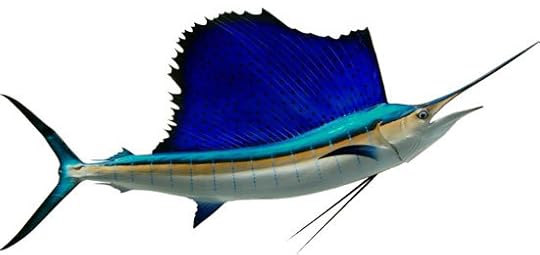
Amazing facts about Sailfish
Sailfish are fast! These are probably the fastest swimming fish on the planet, and many sources say they have been reliably clocked at about 68 miles per hour (110 kilometers per hour). However, some sources say more recent studies indicate they may only swim half that speed. Regardless, that's pretty darn fast when you consider they are moving through a dense liquid (water).
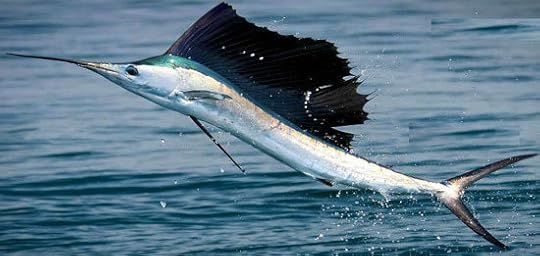
Sailfish grow up to eleven feet long and weigh as much as 220 pounds. And they grow very fast, often reaching 4-5 feet in their first year. They are highly valued as game fish. But since their meat is tough and undesirable, they are almost always released alive after being caught. In fact, many places give out release certificates to fisherman who catch and release them.
It is thought that the main purpose of the huge sail-like dorsal fin is to help "herd" schools of fish (or squid) during the sailfish's elaborate feeding strategy. Normally, these fins are held flat againt the fish's back and are hardly visible. Amazingly, sailfish cooperate with each other (sometimes dozens or even a hundred or more) to feed on schools of smaller "baitfish." They repeatedly swim around the school of baitfish, using their large fin to herd them into a tight ball, and then the sailfish take turns rushing into the ball of baitfish to slash at them with their long bills. This kills or stuns some of the baitfish and then the sailfish swallow them. This goes on and on until they get their fill. Check out this video of their feeding behavior.
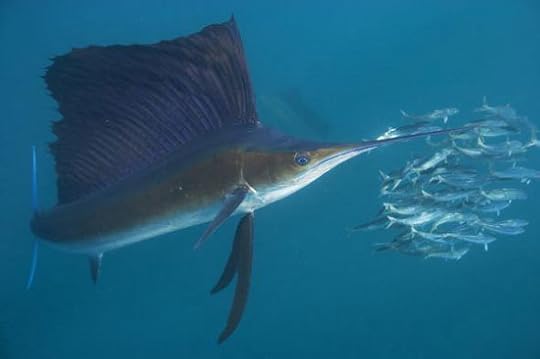
When they get excited or stressed, their skin flashes different iridescent colors. In fact, it is thought that they use these color flashes as they feed in cooperative groups. With numerous sailfish darting into the midst of a tight ball of baitfish to feed, it is possible another sailfish could get injured or killed by the attacker's sharp bill. But since they get excited just before dashing into the ball of fish, their skin changes color, warning the other sailfish to get out of the way.
Sailfish are very widely distributed, and they are not currently endangered or threatened. The map below shows their overall range (although they are certainly more abundant in some of those areas).

When spawning, a large female sailfish will release up to 4,500,000 eggs. Yeesh! Several males will follow her around as she spawns, releasing sperm into the water to fertilize the eggs. Check out this baby sailfish:

So, the Sailfish deserves a place in the J.A.H.O.F. (Jake Animal Hall of Fame).
FUN FACT: Jake is thought to have originated in North America in the early 1900s. It basically means satisfactory, as in "everything was jake again." It is also used in Australia, with variations such as jakealoo and jakerloo.
So, in other words, jake is another way to say awesome.
Photo Credits:
Sailfish mount - King Sailfish Mounts
Sailfishing Jumping - Cape Verde Islands
Sailfish with school of baitfish - Paul Nicklen, National Geographic Creative
Sailfish Distribution Map - Florida Museum
Baby Sailfish - Bob Cowen
But what the heck is a sailfish.
Sailfish are members of the billfish family (Istiophoridae), which also includes marlins. There are two subspecies (or separate species, depending on the source), the Atlantic Sailfish and the Indo-Pacific Sailfish. The sailfish's most striking features are the long, sharp bill (actually the upper jaw) and the tall, flat dorsal fin that stretches most of the length of the body. This dorsal fin is how the fish got its name, sailfish .

Amazing facts about Sailfish
Sailfish are fast! These are probably the fastest swimming fish on the planet, and many sources say they have been reliably clocked at about 68 miles per hour (110 kilometers per hour). However, some sources say more recent studies indicate they may only swim half that speed. Regardless, that's pretty darn fast when you consider they are moving through a dense liquid (water).

Sailfish grow up to eleven feet long and weigh as much as 220 pounds. And they grow very fast, often reaching 4-5 feet in their first year. They are highly valued as game fish. But since their meat is tough and undesirable, they are almost always released alive after being caught. In fact, many places give out release certificates to fisherman who catch and release them.
It is thought that the main purpose of the huge sail-like dorsal fin is to help "herd" schools of fish (or squid) during the sailfish's elaborate feeding strategy. Normally, these fins are held flat againt the fish's back and are hardly visible. Amazingly, sailfish cooperate with each other (sometimes dozens or even a hundred or more) to feed on schools of smaller "baitfish." They repeatedly swim around the school of baitfish, using their large fin to herd them into a tight ball, and then the sailfish take turns rushing into the ball of baitfish to slash at them with their long bills. This kills or stuns some of the baitfish and then the sailfish swallow them. This goes on and on until they get their fill. Check out this video of their feeding behavior.

When they get excited or stressed, their skin flashes different iridescent colors. In fact, it is thought that they use these color flashes as they feed in cooperative groups. With numerous sailfish darting into the midst of a tight ball of baitfish to feed, it is possible another sailfish could get injured or killed by the attacker's sharp bill. But since they get excited just before dashing into the ball of fish, their skin changes color, warning the other sailfish to get out of the way.
Sailfish are very widely distributed, and they are not currently endangered or threatened. The map below shows their overall range (although they are certainly more abundant in some of those areas).

When spawning, a large female sailfish will release up to 4,500,000 eggs. Yeesh! Several males will follow her around as she spawns, releasing sperm into the water to fertilize the eggs. Check out this baby sailfish:

So, the Sailfish deserves a place in the J.A.H.O.F. (Jake Animal Hall of Fame).
FUN FACT: Jake is thought to have originated in North America in the early 1900s. It basically means satisfactory, as in "everything was jake again." It is also used in Australia, with variations such as jakealoo and jakerloo.
So, in other words, jake is another way to say awesome.
Photo Credits:
Sailfish mount - King Sailfish Mounts
Sailfishing Jumping - Cape Verde Islands
Sailfish with school of baitfish - Paul Nicklen, National Geographic Creative
Sailfish Distribution Map - Florida Museum
Baby Sailfish - Bob Cowen
Published on October 28, 2017 11:03
Parthenium's Year is here!
My new novella,
Parthenium's Year
, is now available, and for a limited time you can grab it for 99¢ (the price will go up on November 10). It is also in Kindle Unlimited if you have access to that.

I have to take a moment to tell you how excited I am about Parthenium's Year . This is the first book I have published that is not part of the Diffusion series, and I had a great time writing it.
Parthenium's Year is a story of love. But as you probably know, I cannot write a book without some strange things happening. My stories are about ordinary people who find themselves in extraordinary circumstances. In Parthenium's Year , Spencer meets someone who changes his life. But she comes from a very unusual family.
I live in Missouri, a state in the Midwest US that encompasses much of the area known as the Ozarks, where there is a rich history of fascinating traditions, folklore, art, and music. And in my own special way, Parthenium's Year expresses my love for this area.
You can get Parthenium's Year on Amazon.

I have to take a moment to tell you how excited I am about Parthenium's Year . This is the first book I have published that is not part of the Diffusion series, and I had a great time writing it.
Parthenium's Year is a story of love. But as you probably know, I cannot write a book without some strange things happening. My stories are about ordinary people who find themselves in extraordinary circumstances. In Parthenium's Year , Spencer meets someone who changes his life. But she comes from a very unusual family.
I live in Missouri, a state in the Midwest US that encompasses much of the area known as the Ozarks, where there is a rich history of fascinating traditions, folklore, art, and music. And in my own special way, Parthenium's Year expresses my love for this area.
You can get Parthenium's Year on Amazon.
Published on October 28, 2017 10:58
October 22, 2017
Awesome Animal - No-See-Um
As we get into the cooler weather of the fall, I start spending more time in Missouri's forests. Well, there's good and bad to that. If you've read any of my posts, you know I love being outdoors. But our forests here are not without hazards: ticks, chiggers, mosquitoes, no-see-ums, and my nemesis, poison ivy. If you don't have poison ivy where you live, consider yourself lucky. Yes, I know in some areas there are also venomous snakes, crocodiles, and large predators, but I don't fear those because they can be avoided with common-sense precautions. It's the little things that are more of a threat to me, the things that are much harder to avoid. For example, here's what my arm looks like right now, due to a recent encounter with poison ivy:

I know, I know, you're tempted to say I can avoid such things by simply staying out of the woods. But that's not an option, because I feel a deep connection to nature and spending time in the woods (or in the water, or on the prairie, etc.) is essential to my peaceful and contented state of mind.
And so this leads to today's Awesome Animal... the no-see-um .
Have you read Profusion yet? If so, you know that the entire world is threatened by a profusion of horrifying creatures. Bobby makes a plan to try to stop it, and ironically his plan involves the smallest flying insect he can think of... the no-see-um .
But what the heck is a no-see-um?
No-see-ums are called different names in different parts of the world. They are actually a type of fly (the order Diptera), but they are much smaller than many other flies such as mosquitoes or deer flies. In fact, some of them are so small you simply cannot see them without a magnifier. So you don't know they are on your skin until you feel them biting you. That's how they got their name, no-see-um .
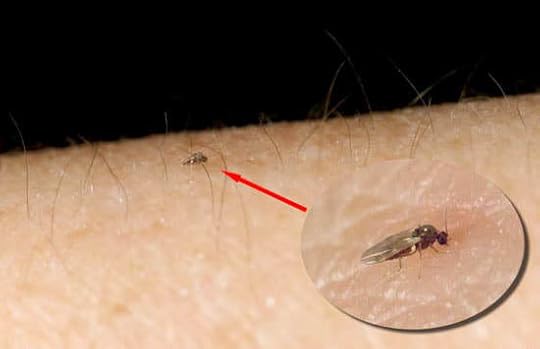
Amazing facts about No-See-Ums
Most of the insects people call no-see-ums are in a family of flies referred to as biting midges . Depending on where you're from, you may have heard them called midgies, knotts, moose flies, sand flies, punkies, or biting gnats. some of these names, though, like gnats and sand flies, are ambiguous because they are used for a number of other insect groups. Amazingly, there are 4,000 to 5,000 species of no-see-ums (biting midges) that we know of, and they live in almost every part of the world. They've even been found on Mount Everest!
No-see-ums are so small they can fly right through typical screens on windows and doors. Whenever I purchase a tent, I make sure the windows are made of "no-see-um netting," a special type of netting with very small holes. In order to block no-see-ums, the netting must have mesh size of at least 4,900 holes per square inch! They also make head nets with the stuff:

No-see-ums can drive a person crazy, because they bite! Like with mosquitoes, it is the females that bite. The females have a needle-like sucker along with a separate injector tube. The sucker is obviously for sucking up blood. The injector tube is used to inject a small amount of anticoagulant, to keep the blood from clotting so it will flow freely up the sucker tube. It is actually our body's allergic reaction to this anticoagulant that causes the itch. Some people are more allergic to it than others. Fortunately for me, the itch only lasts about 20 minutes, but for some people it can go on for several days or even weeks.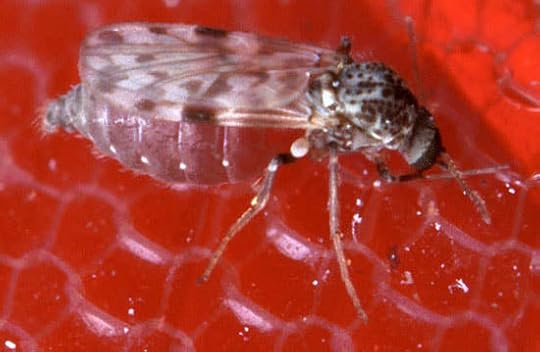
Female no-see-ums seek out blood for the same reason female mosquitoes do--to get nourishment for the development of their eggs. Once she gets a blood meal, the female will lay her eggs on water or wet mud or sand (water is necessary for the larvae). For most species, the larvae feed for about 28 days before becoming adult no-see-ums (although it can take up to a year in some cold climates).
A female can lay 400 or more eggs at a time, and she can breed 5-7 times in her adult life. No wonder these things can be so abundant!
No-see-ums (along with gull midges) are the only pollinators of the cacao tree. So without them, we would have no chocolate .
No-see-ums are drawn to mammals (including humans) by the odor of carbon dioxide (which we exhale) and the odor of lactic acid (which is made in our muscles and red blood cells). So this means that CO2 mosquito traps are also effective for no-see-ums.
The real question is, if you can't see them, do they exist?
 So, the No-See-Um deserves a place in the V.G.A.H.O.F. (V.G. Animal Hall of Fame).
So, the No-See-Um deserves a place in the V.G.A.H.O.F. (V.G. Animal Hall of Fame).
FUN FACT: V.G. is an initialism for Very Good. Surprisingly, this abbreviation has been part of the English language since the 1860s. It showed up then in the Oxford English Dictionary, in a quote about a prison guard: “[he] was not in their [i.e. the prisoners’] opinion sufficiently liberal with his V.G.’s (‘Very Good,’ as marked in the accounts.)”
So, in other words, V.G. is another way to say awesome.
Photo Credits:
No-see-um Enlarged - Jarmo Holopainen
Blood-filled midge - Wikimedia Commons
Calvin and Hobbes - GoComics

I know, I know, you're tempted to say I can avoid such things by simply staying out of the woods. But that's not an option, because I feel a deep connection to nature and spending time in the woods (or in the water, or on the prairie, etc.) is essential to my peaceful and contented state of mind.
And so this leads to today's Awesome Animal... the no-see-um .
Have you read Profusion yet? If so, you know that the entire world is threatened by a profusion of horrifying creatures. Bobby makes a plan to try to stop it, and ironically his plan involves the smallest flying insect he can think of... the no-see-um .
But what the heck is a no-see-um?
No-see-ums are called different names in different parts of the world. They are actually a type of fly (the order Diptera), but they are much smaller than many other flies such as mosquitoes or deer flies. In fact, some of them are so small you simply cannot see them without a magnifier. So you don't know they are on your skin until you feel them biting you. That's how they got their name, no-see-um .

Amazing facts about No-See-Ums
Most of the insects people call no-see-ums are in a family of flies referred to as biting midges . Depending on where you're from, you may have heard them called midgies, knotts, moose flies, sand flies, punkies, or biting gnats. some of these names, though, like gnats and sand flies, are ambiguous because they are used for a number of other insect groups. Amazingly, there are 4,000 to 5,000 species of no-see-ums (biting midges) that we know of, and they live in almost every part of the world. They've even been found on Mount Everest!
No-see-ums are so small they can fly right through typical screens on windows and doors. Whenever I purchase a tent, I make sure the windows are made of "no-see-um netting," a special type of netting with very small holes. In order to block no-see-ums, the netting must have mesh size of at least 4,900 holes per square inch! They also make head nets with the stuff:

No-see-ums can drive a person crazy, because they bite! Like with mosquitoes, it is the females that bite. The females have a needle-like sucker along with a separate injector tube. The sucker is obviously for sucking up blood. The injector tube is used to inject a small amount of anticoagulant, to keep the blood from clotting so it will flow freely up the sucker tube. It is actually our body's allergic reaction to this anticoagulant that causes the itch. Some people are more allergic to it than others. Fortunately for me, the itch only lasts about 20 minutes, but for some people it can go on for several days or even weeks.

Female no-see-ums seek out blood for the same reason female mosquitoes do--to get nourishment for the development of their eggs. Once she gets a blood meal, the female will lay her eggs on water or wet mud or sand (water is necessary for the larvae). For most species, the larvae feed for about 28 days before becoming adult no-see-ums (although it can take up to a year in some cold climates).
A female can lay 400 or more eggs at a time, and she can breed 5-7 times in her adult life. No wonder these things can be so abundant!
No-see-ums (along with gull midges) are the only pollinators of the cacao tree. So without them, we would have no chocolate .
No-see-ums are drawn to mammals (including humans) by the odor of carbon dioxide (which we exhale) and the odor of lactic acid (which is made in our muscles and red blood cells). So this means that CO2 mosquito traps are also effective for no-see-ums.
The real question is, if you can't see them, do they exist?
 So, the No-See-Um deserves a place in the V.G.A.H.O.F. (V.G. Animal Hall of Fame).
So, the No-See-Um deserves a place in the V.G.A.H.O.F. (V.G. Animal Hall of Fame).FUN FACT: V.G. is an initialism for Very Good. Surprisingly, this abbreviation has been part of the English language since the 1860s. It showed up then in the Oxford English Dictionary, in a quote about a prison guard: “[he] was not in their [i.e. the prisoners’] opinion sufficiently liberal with his V.G.’s (‘Very Good,’ as marked in the accounts.)”
So, in other words, V.G. is another way to say awesome.
Photo Credits:
No-see-um Enlarged - Jarmo Holopainen
Blood-filled midge - Wikimedia Commons
Calvin and Hobbes - GoComics
Published on October 22, 2017 05:43
October 4, 2017
Awesome Animal - Sago Grub
If you have read any of my novels, you know that Sago grubs are an important part of the diet of Papuan villagers (on the western half of the island of New Guinea, the Indonesian province of Papua).
But what the heck is a sago grub?
Sago grubs are actually the larvae of a large beetle called the Sago Palm Weevil, a species of snout beetle that feeds on the rotting trunks of the Sago Palm. These beetle larvae can be as fat as your finger. They may look disgusting to anyone who is not accustomed to eating insects, but they are packed with great nutrients and are said to be delicious.

Amazing facts about Sago Grubs
Sago grubs are considered a tasty treat throughout Indonesia, Vietnam, and Papua New Guinea. The people of some cultures like to eat them raw, and they describe the taste as creamy. Other people like to cook them, and the taste of the cooked grubs is described as resembling bacon or other meat.
Of course sago grubs have varying significance for every culture that consumes them. New Guinea is home to hundreds of tribes with different customs, but the ritual of the sago grub feast is common throughout most of these tribes. The sago grub feast is a way to celebrate fertility and prosperity. Sago grub feasts are held at least once during the lifetime of each generation, and one feast can involve a sequence of events that goes on for many months. These feasts are a big deal, to say the least. The host tribe invites numerous guests, based on complex rules of genealogical relationships. These rituals often involve dancing, as well as exchanging valuable gifts such as pigs and shells (among other things). Check out this video of a sago grub feast in Papua.
Harvesting sago grubs is amazingly difficult and time-consuming.Tribesmen cut down sago palms (not an easy task in itself). And they return to the fallen trees after 1 to 3 months to gather the Sago Palm weevil larvae (grubs) that have hatched in the trunk and have grown large by feeding on the rotting wood. Splitting open the rotting tree is labor-intensive and takes hours of hard work.
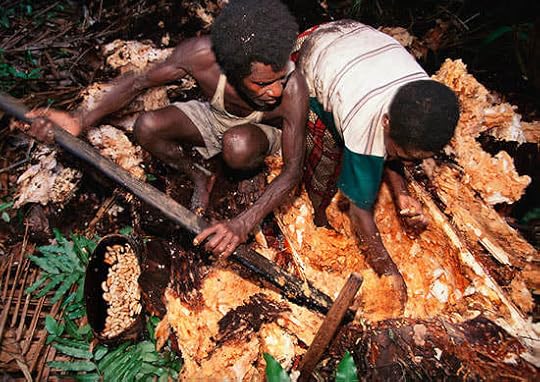
If they wait too long to harvest the sago grubs, the larvae will mature and turn into adult Sago Palm Beetles, which are not desirable to eat.
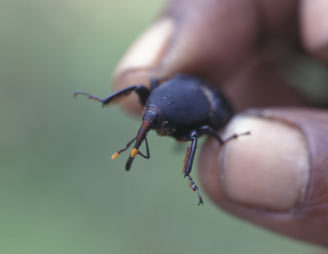
Not only are sago grubs tasty, and they play an important role in traditional rituals, but they are also extremely nutritious. Five large sago grubs (weighing about 40 grams total) will contain 3 grams of protein and as much as 12 grams of fat.
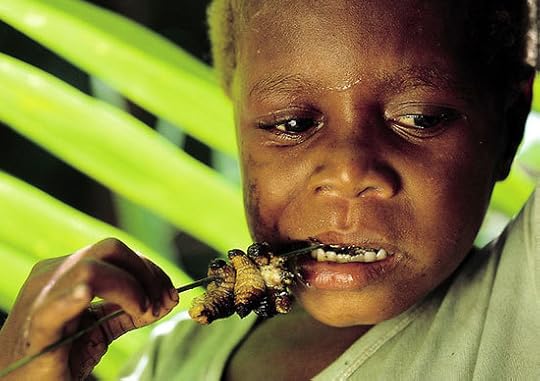
Palm Weevil grubs have even shown up in hoax news reports. A newspaper in Italy ran a story (and the photo below) of firefighters in Naples finding a larva the size of a full-grown pig. According to the article, the creature let out a shrill cry, similar to the whinny of a horse. Imagine the feast you could have with that one! Of course this is fake.

So, the Sago Grub deserves a place in the D.A.H.O.F. (Deevy Animal Hall of Fame).
FUN FACT: Deevy is a word extracted from divvy, which in turn was extracted from divine. Deevy was used as early as 1900 (Elinor Glyn used it in her 1900 novel, Visits of Elizabeth). So, in other words, deevy is another way to say awesome.
Photo Credits:
Sago Grub in hands - Sean Linnane
Collecting Sago Grubs - Peter Menzel
Adult Palm Weevil Beetle - Kal Muller
Papuan child eating roasted sago grubs - Peter Menzel
Giant Larvae Hoax - Musem of Hoaxes
But what the heck is a sago grub?
Sago grubs are actually the larvae of a large beetle called the Sago Palm Weevil, a species of snout beetle that feeds on the rotting trunks of the Sago Palm. These beetle larvae can be as fat as your finger. They may look disgusting to anyone who is not accustomed to eating insects, but they are packed with great nutrients and are said to be delicious.

Amazing facts about Sago Grubs
Sago grubs are considered a tasty treat throughout Indonesia, Vietnam, and Papua New Guinea. The people of some cultures like to eat them raw, and they describe the taste as creamy. Other people like to cook them, and the taste of the cooked grubs is described as resembling bacon or other meat.
Of course sago grubs have varying significance for every culture that consumes them. New Guinea is home to hundreds of tribes with different customs, but the ritual of the sago grub feast is common throughout most of these tribes. The sago grub feast is a way to celebrate fertility and prosperity. Sago grub feasts are held at least once during the lifetime of each generation, and one feast can involve a sequence of events that goes on for many months. These feasts are a big deal, to say the least. The host tribe invites numerous guests, based on complex rules of genealogical relationships. These rituals often involve dancing, as well as exchanging valuable gifts such as pigs and shells (among other things). Check out this video of a sago grub feast in Papua.
Harvesting sago grubs is amazingly difficult and time-consuming.Tribesmen cut down sago palms (not an easy task in itself). And they return to the fallen trees after 1 to 3 months to gather the Sago Palm weevil larvae (grubs) that have hatched in the trunk and have grown large by feeding on the rotting wood. Splitting open the rotting tree is labor-intensive and takes hours of hard work.

If they wait too long to harvest the sago grubs, the larvae will mature and turn into adult Sago Palm Beetles, which are not desirable to eat.

Not only are sago grubs tasty, and they play an important role in traditional rituals, but they are also extremely nutritious. Five large sago grubs (weighing about 40 grams total) will contain 3 grams of protein and as much as 12 grams of fat.

Palm Weevil grubs have even shown up in hoax news reports. A newspaper in Italy ran a story (and the photo below) of firefighters in Naples finding a larva the size of a full-grown pig. According to the article, the creature let out a shrill cry, similar to the whinny of a horse. Imagine the feast you could have with that one! Of course this is fake.

So, the Sago Grub deserves a place in the D.A.H.O.F. (Deevy Animal Hall of Fame).
FUN FACT: Deevy is a word extracted from divvy, which in turn was extracted from divine. Deevy was used as early as 1900 (Elinor Glyn used it in her 1900 novel, Visits of Elizabeth). So, in other words, deevy is another way to say awesome.
Photo Credits:
Sago Grub in hands - Sean Linnane
Collecting Sago Grubs - Peter Menzel
Adult Palm Weevil Beetle - Kal Muller
Papuan child eating roasted sago grubs - Peter Menzel
Giant Larvae Hoax - Musem of Hoaxes
Published on October 04, 2017 12:53
Profusion is one month old!
Wow, hard to believe, but it has been a month since my new novel,
Profusion
, was released!
On Saturday (Sept. 30) I tried something I've never done before: a Book Release Party. Our local bookstore asked me if I wanted to do this. At first I was unsure, but then I thought, "Okay, why shouldn't I celebrate all those months of hard work?"
So I decided to run with it and just have a good time. Trish and I came up with some activities and fun snacks. We had a scavenger hunt in the store. People searched for animals from the Diffusion series that were hiding among the books. By carefully considering the clues, they found the specific books, and therefore the animals.
Our snacks were based on animals from the Diffusion books. For example, we had green tree pythons:

And we had New Guinea Crocodiles (made with Nutter Butter cookies):

And here are a few of the others:

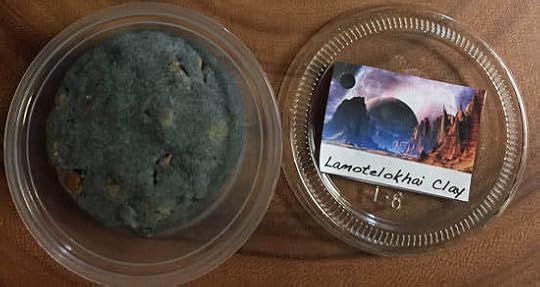
 I know, I know. It's all very silly. But it gets worse. Because I told jokes. Really bad ones. Examples, you ask?
I know, I know. It's all very silly. But it gets worse. Because I told jokes. Really bad ones. Examples, you ask?
What do you call a lazy baby tree kangaroo? A pouch potato.
Tree kangaroos can jump higher than a house. Because houses can't jump.
You know where kangaroos like to eat breakfast? At iHop.
I did a 15-minute reading from Profusion, and I even did a ventriloquist act with my stuffed tree kangaroo, Tupela:

Overall, it was terrific fun. But it involved a lot of preparation, so I'm not sure I'll try to do it again. But who knows? After completing my next book, I may be ready to celebrate all over again!
On Saturday (Sept. 30) I tried something I've never done before: a Book Release Party. Our local bookstore asked me if I wanted to do this. At first I was unsure, but then I thought, "Okay, why shouldn't I celebrate all those months of hard work?"
So I decided to run with it and just have a good time. Trish and I came up with some activities and fun snacks. We had a scavenger hunt in the store. People searched for animals from the Diffusion series that were hiding among the books. By carefully considering the clues, they found the specific books, and therefore the animals.
Our snacks were based on animals from the Diffusion books. For example, we had green tree pythons:

And we had New Guinea Crocodiles (made with Nutter Butter cookies):

And here are a few of the others:


 I know, I know. It's all very silly. But it gets worse. Because I told jokes. Really bad ones. Examples, you ask?
I know, I know. It's all very silly. But it gets worse. Because I told jokes. Really bad ones. Examples, you ask?What do you call a lazy baby tree kangaroo? A pouch potato.
Tree kangaroos can jump higher than a house. Because houses can't jump.
You know where kangaroos like to eat breakfast? At iHop.
I did a 15-minute reading from Profusion, and I even did a ventriloquist act with my stuffed tree kangaroo, Tupela:

Overall, it was terrific fun. But it involved a lot of preparation, so I'm not sure I'll try to do it again. But who knows? After completing my next book, I may be ready to celebrate all over again!
Published on October 04, 2017 12:34
September 12, 2017
Awesome Animal - Nothosaurus
My books in the Diffusion series are filled with amazing creatures, some which are cute and cuddly, but many which are downright scary. That's what makes it fun, right? In
Profusion
, Bobby has a terrifying encounter with a creature called a
n
othosaurus
.
The nothosaurus (meaning "false lizard") was a reptile that lived from about 240 to 210 million years ago. It was widespread, with fossils being found throughout North America, Europe, and China. As prehistoric aquatic reptiles go, the nothosaurus was not particularly large, averaging less than 13 feet (4 meters) long. Today's crocodiles get considerably larger. But that doesn't mean you would want one to grab onto you while you're taking a swim. They had wide, flat mouths with very sharp teeth.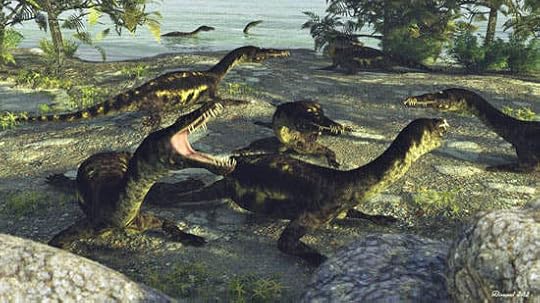 Amazing facts about the Nothosaurus
Amazing facts about the Nothosaurus
These creatures had strong legs (unlike the flippers of many of the more aquatically-adapted marine reptiles that came later), and they could probably walk on land, perhaps about as well as today's seals and sea lions. This is why one of these was able to come out of the water and pursue Bobby (in Profusion ). Many of them even had clawed feet rather than flippers. See the image below.
 Nothosaurs had very long, sharp teeth adapted for catching fish (and perhaps any other smaller aquatic creatures, such as squid). We have an idea of how they hunted because scientists have found fossils of trackways left behind as they dug into the soft seabed with their paddle-like forelimbs, probably trying to churn up hiding creatures, which they would snap up in their teeth. See trackway in the image below.
Nothosaurs had very long, sharp teeth adapted for catching fish (and perhaps any other smaller aquatic creatures, such as squid). We have an idea of how they hunted because scientists have found fossils of trackways left behind as they dug into the soft seabed with their paddle-like forelimbs, probably trying to churn up hiding creatures, which they would snap up in their teeth. See trackway in the image below.
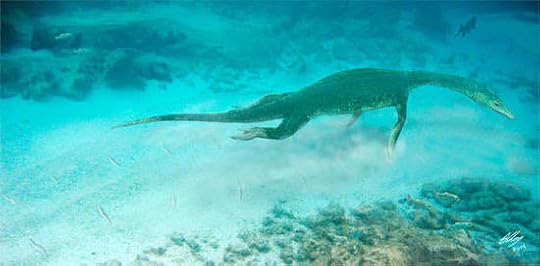 There were at least twelve species of nothosaurus (probably more, as a very small percentage of prehistoric animals became fossilized). The first nothosaurus fossil to be found and identified was in Germany in 1833. See the photo below from the Berlin Museum of Natural History.
There were at least twelve species of nothosaurus (probably more, as a very small percentage of prehistoric animals became fossilized). The first nothosaurus fossil to be found and identified was in Germany in 1833. See the photo below from the Berlin Museum of Natural History.  Want to get a feel for the size and shape of the nothosaurus? Take a look at this video of a walk-around of a life-size replica in a museum in Karlsruhe, Germany.
Want to get a feel for the size and shape of the nothosaurus? Take a look at this video of a walk-around of a life-size replica in a museum in Karlsruhe, Germany.
Based upon their body structure, nothosaurs probably spent most of their time on land near the water (like today's seals), sliding into the water mainly to feed. I wonder if they also were as playful in the water as today's seals are...? I also wonder what kind of vocalizations they made. Did they bark like seals?
We still don't know if nothosaurus laid eggs or gave birth to live young. But it's likely they had live birth, because many of the ichthyosaurs (and the later plesiosaurs) had live birth, and they are thought to have evolved from the nothosaurs. But we still don't have an accurate estimate of when live birth in marine reptiles began.
So, the Nothosaurus deserves a place in the B.A.H.O.F. (Bad Animal Hall of Fame).
FUN FACT: Bad is an example of a word that has evolved to mean the opposite of its original meaning. It was popularized in 1987 by Michael Jackson with his hit song, Bad. But most people don't know that "bad" was used to mean "good" long before that. The earliest reference in the Oxford English Dictionary was from the 1897 Pink Marsh, by George Ade: “She sutny fix up a pohk chop ‘at’s bad to eat.” So, in other words, bad is another way to say awesome.
Photo Credits:
Nothosaurus group by shore - Dinoraul on Renderosity
Detailed Nothosaur, showing feet - DK Findout!
Nothosaurus leaving trackway - Nature.com-Original artwork Brian Choo
Nothosaurus Fossil Skeleton - Berlin Museum of Natural History, photo by Elke Wetzig
The nothosaurus (meaning "false lizard") was a reptile that lived from about 240 to 210 million years ago. It was widespread, with fossils being found throughout North America, Europe, and China. As prehistoric aquatic reptiles go, the nothosaurus was not particularly large, averaging less than 13 feet (4 meters) long. Today's crocodiles get considerably larger. But that doesn't mean you would want one to grab onto you while you're taking a swim. They had wide, flat mouths with very sharp teeth.
 Amazing facts about the Nothosaurus
Amazing facts about the Nothosaurus
These creatures had strong legs (unlike the flippers of many of the more aquatically-adapted marine reptiles that came later), and they could probably walk on land, perhaps about as well as today's seals and sea lions. This is why one of these was able to come out of the water and pursue Bobby (in Profusion ). Many of them even had clawed feet rather than flippers. See the image below.
 Nothosaurs had very long, sharp teeth adapted for catching fish (and perhaps any other smaller aquatic creatures, such as squid). We have an idea of how they hunted because scientists have found fossils of trackways left behind as they dug into the soft seabed with their paddle-like forelimbs, probably trying to churn up hiding creatures, which they would snap up in their teeth. See trackway in the image below.
Nothosaurs had very long, sharp teeth adapted for catching fish (and perhaps any other smaller aquatic creatures, such as squid). We have an idea of how they hunted because scientists have found fossils of trackways left behind as they dug into the soft seabed with their paddle-like forelimbs, probably trying to churn up hiding creatures, which they would snap up in their teeth. See trackway in the image below. There were at least twelve species of nothosaurus (probably more, as a very small percentage of prehistoric animals became fossilized). The first nothosaurus fossil to be found and identified was in Germany in 1833. See the photo below from the Berlin Museum of Natural History.
There were at least twelve species of nothosaurus (probably more, as a very small percentage of prehistoric animals became fossilized). The first nothosaurus fossil to be found and identified was in Germany in 1833. See the photo below from the Berlin Museum of Natural History.  Want to get a feel for the size and shape of the nothosaurus? Take a look at this video of a walk-around of a life-size replica in a museum in Karlsruhe, Germany.
Want to get a feel for the size and shape of the nothosaurus? Take a look at this video of a walk-around of a life-size replica in a museum in Karlsruhe, Germany.Based upon their body structure, nothosaurs probably spent most of their time on land near the water (like today's seals), sliding into the water mainly to feed. I wonder if they also were as playful in the water as today's seals are...? I also wonder what kind of vocalizations they made. Did they bark like seals?
We still don't know if nothosaurus laid eggs or gave birth to live young. But it's likely they had live birth, because many of the ichthyosaurs (and the later plesiosaurs) had live birth, and they are thought to have evolved from the nothosaurs. But we still don't have an accurate estimate of when live birth in marine reptiles began.
So, the Nothosaurus deserves a place in the B.A.H.O.F. (Bad Animal Hall of Fame).
FUN FACT: Bad is an example of a word that has evolved to mean the opposite of its original meaning. It was popularized in 1987 by Michael Jackson with his hit song, Bad. But most people don't know that "bad" was used to mean "good" long before that. The earliest reference in the Oxford English Dictionary was from the 1897 Pink Marsh, by George Ade: “She sutny fix up a pohk chop ‘at’s bad to eat.” So, in other words, bad is another way to say awesome.
Photo Credits:
Nothosaurus group by shore - Dinoraul on Renderosity
Detailed Nothosaur, showing feet - DK Findout!
Nothosaurus leaving trackway - Nature.com-Original artwork Brian Choo
Nothosaurus Fossil Skeleton - Berlin Museum of Natural History, photo by Elke Wetzig
Published on September 12, 2017 05:50
August 31, 2017
Awesome Animal - Snow Goose
I like to feature animals that make an appearance in my books, and today's critter makes a most spectacular appearance in
Profusion
. In fact, you could even say it's a save-the-world kind of appearance!
Imagine standing in the middle of a flock of over a million white, cackling geese spread out over the ground for as far as you can see. Then imagine that something triggers the birds to take off. In a roar of millions of wings and high-pitched voices, the geese lift from the ground and take to the sky, circling above you like a white tornado.
Yes, the scene above takes place in Profusion , but this is something you can also experience in real life. At least you can if you visit the North American migration corridors of the lesser snow goose or greater snow goose. They migrate in groups of hundreds of thousands, and their movements are one of the most impressive migration events on Earth.
 The hunting of snow geese was stopped in 1916 because their numbers had been drastically reduced. By 1975 their numbers had recovered, and hunting them was reinstated. But since the 1970s, their numbers have increased by 300%. They are getting so overpopulated that huge flocks of them are inflicting irreparable damage to the fragile tundra habitats where they feed and nest in the summers.
The hunting of snow geese was stopped in 1916 because their numbers had been drastically reduced. By 1975 their numbers had recovered, and hunting them was reinstated. But since the 1970s, their numbers have increased by 300%. They are getting so overpopulated that huge flocks of them are inflicting irreparable damage to the fragile tundra habitats where they feed and nest in the summers.
Amazing facts about the Snow Goose
Snow geese like to migrate in groups. Often they will be in flocks of thousands. In fact, if you are near one of the places where they rest in large numbers, it isn't unusual to see flocks of several hundred thousand. I have been at the Grand Pass Conservation Area here in Missouri on days when there are 1.2 million gathered in one area. When they come in to land, it looks like a giant, gently swirling tornado. Check out this video showing some great scenes of migrating flocks.
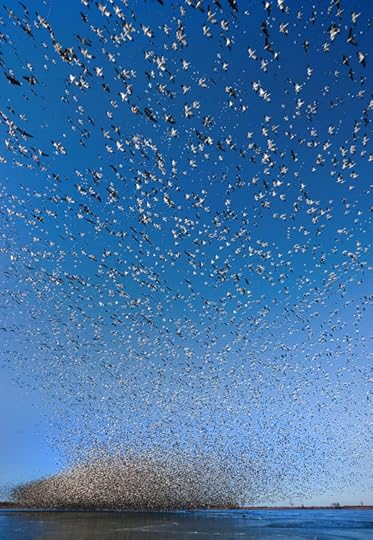 The blue goose used to be considered a separate species, but now we know it is just a color variation of the snow goose that is caused by only one gene. The blue gene is slightly dominant to the white gene. If two white geese mate, they will have all white offspring. But if a white and blue goose mate, usually all the offspring will be blue (although they may have white bellies). And if two blue geese mate, they will have mostly blue, but some white geese. What I find interesting is that, at least here in the Midwest US, the proportion of blue geese has increased in the ten years I have been observing them. Now it seems as if about 30% of each large flock is blue geese. See the comparison below.
The blue goose used to be considered a separate species, but now we know it is just a color variation of the snow goose that is caused by only one gene. The blue gene is slightly dominant to the white gene. If two white geese mate, they will have all white offspring. But if a white and blue goose mate, usually all the offspring will be blue (although they may have white bellies). And if two blue geese mate, they will have mostly blue, but some white geese. What I find interesting is that, at least here in the Midwest US, the proportion of blue geese has increased in the ten years I have been observing them. Now it seems as if about 30% of each large flock is blue geese. See the comparison below.
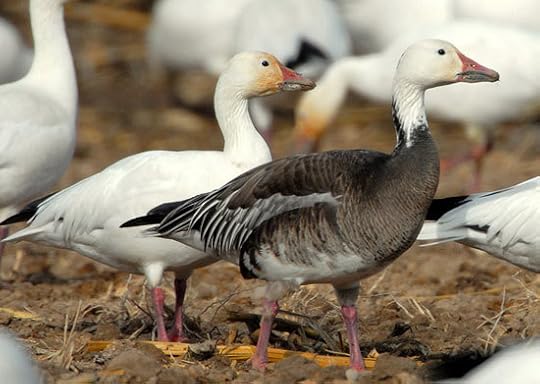 Snow goose goslings are very well developed when they hatch. They have soft downy feathers that immediately show whether they will turn out to be white or blue. And they can walk VERY well. In fact, in the arctic areas where they breed, the newly-hatched chicks can often walk with their parents up to 50 miles over a three-week period in order to find a better rearing area.
Snow goose goslings are very well developed when they hatch. They have soft downy feathers that immediately show whether they will turn out to be white or blue. And they can walk VERY well. In fact, in the arctic areas where they breed, the newly-hatched chicks can often walk with their parents up to 50 miles over a three-week period in order to find a better rearing area.
Snow geese can live up to 27 years. One of the important ways biologists study them is to put metal bands on their feet. When hunters shoot these banded birds, they report the information to an online database, which allows biologists to better understand migration patterns, breeding behavior, and longevity.
Snow geese are poop factories. Food passes through their digestive tract in only an hour or two. This means they can poop up to 15 times per hour. And they are especially productive (poopwise) when feeding on rhizomes, which are high in fiber (and the geese swallow lots of mud as they eat them).
Snow geese have become so abundant in the last few decades that they are causing severe damage to their tundra feeding grounds. Why? Because the birds feed on the grasses. And now that the flocks are larger than ever, they run out of grasses and start feeding on the underground rhizomes (specialized underground stems) of the grass, making it so the grass cannot grow back. They are turning arctic grasslands into salty mud flats.
In an attempt to control the exploding population, the US Fish and Wildlife Service in 1999 initiated new rules that allowed 24 US states to create opportunities for hunting enthusiasts to harvest as many of the birds as possible. I happen to enjoy snow goose hunting, but it isn't an easy sport. Snow geese are notoriously difficult to decoy, and it takes hundreds of decoys and lots of hard work. See image below. Unfortunately, these efforts are not decreasing the population much.
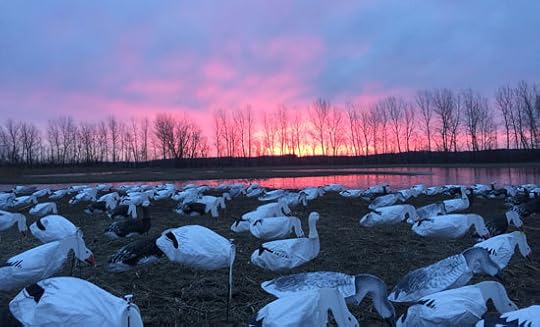 So, the Snow Goose deserves a place in the F.A.H.O.F. (Fizzing Animal Hall of Fame).
So, the Snow Goose deserves a place in the F.A.H.O.F. (Fizzing Animal Hall of Fame).
FUN FACT: Fizzing is one of several words associated with a sound that have gradually become adjectives implying that something is excellent. Ripping is another example (I had a ripping time last night). So, in other words, fizzing is another way to say awesome.
Photo Credits:
Snow Goose Flock #1 - George C. Reifel Migratory Bird Sactuary
Snow Goose Flock #2 - Mike Hollingshead
Snow Goose, Blue Goose - Paul Higgins
Snow Goose Hunting Sunrise - Stan C. Smith
Imagine standing in the middle of a flock of over a million white, cackling geese spread out over the ground for as far as you can see. Then imagine that something triggers the birds to take off. In a roar of millions of wings and high-pitched voices, the geese lift from the ground and take to the sky, circling above you like a white tornado.
Yes, the scene above takes place in Profusion , but this is something you can also experience in real life. At least you can if you visit the North American migration corridors of the lesser snow goose or greater snow goose. They migrate in groups of hundreds of thousands, and their movements are one of the most impressive migration events on Earth.
 The hunting of snow geese was stopped in 1916 because their numbers had been drastically reduced. By 1975 their numbers had recovered, and hunting them was reinstated. But since the 1970s, their numbers have increased by 300%. They are getting so overpopulated that huge flocks of them are inflicting irreparable damage to the fragile tundra habitats where they feed and nest in the summers.
The hunting of snow geese was stopped in 1916 because their numbers had been drastically reduced. By 1975 their numbers had recovered, and hunting them was reinstated. But since the 1970s, their numbers have increased by 300%. They are getting so overpopulated that huge flocks of them are inflicting irreparable damage to the fragile tundra habitats where they feed and nest in the summers.Amazing facts about the Snow Goose
Snow geese like to migrate in groups. Often they will be in flocks of thousands. In fact, if you are near one of the places where they rest in large numbers, it isn't unusual to see flocks of several hundred thousand. I have been at the Grand Pass Conservation Area here in Missouri on days when there are 1.2 million gathered in one area. When they come in to land, it looks like a giant, gently swirling tornado. Check out this video showing some great scenes of migrating flocks.
 The blue goose used to be considered a separate species, but now we know it is just a color variation of the snow goose that is caused by only one gene. The blue gene is slightly dominant to the white gene. If two white geese mate, they will have all white offspring. But if a white and blue goose mate, usually all the offspring will be blue (although they may have white bellies). And if two blue geese mate, they will have mostly blue, but some white geese. What I find interesting is that, at least here in the Midwest US, the proportion of blue geese has increased in the ten years I have been observing them. Now it seems as if about 30% of each large flock is blue geese. See the comparison below.
The blue goose used to be considered a separate species, but now we know it is just a color variation of the snow goose that is caused by only one gene. The blue gene is slightly dominant to the white gene. If two white geese mate, they will have all white offspring. But if a white and blue goose mate, usually all the offspring will be blue (although they may have white bellies). And if two blue geese mate, they will have mostly blue, but some white geese. What I find interesting is that, at least here in the Midwest US, the proportion of blue geese has increased in the ten years I have been observing them. Now it seems as if about 30% of each large flock is blue geese. See the comparison below. Snow goose goslings are very well developed when they hatch. They have soft downy feathers that immediately show whether they will turn out to be white or blue. And they can walk VERY well. In fact, in the arctic areas where they breed, the newly-hatched chicks can often walk with their parents up to 50 miles over a three-week period in order to find a better rearing area.
Snow goose goslings are very well developed when they hatch. They have soft downy feathers that immediately show whether they will turn out to be white or blue. And they can walk VERY well. In fact, in the arctic areas where they breed, the newly-hatched chicks can often walk with their parents up to 50 miles over a three-week period in order to find a better rearing area.Snow geese can live up to 27 years. One of the important ways biologists study them is to put metal bands on their feet. When hunters shoot these banded birds, they report the information to an online database, which allows biologists to better understand migration patterns, breeding behavior, and longevity.
Snow geese are poop factories. Food passes through their digestive tract in only an hour or two. This means they can poop up to 15 times per hour. And they are especially productive (poopwise) when feeding on rhizomes, which are high in fiber (and the geese swallow lots of mud as they eat them).
Snow geese have become so abundant in the last few decades that they are causing severe damage to their tundra feeding grounds. Why? Because the birds feed on the grasses. And now that the flocks are larger than ever, they run out of grasses and start feeding on the underground rhizomes (specialized underground stems) of the grass, making it so the grass cannot grow back. They are turning arctic grasslands into salty mud flats.
In an attempt to control the exploding population, the US Fish and Wildlife Service in 1999 initiated new rules that allowed 24 US states to create opportunities for hunting enthusiasts to harvest as many of the birds as possible. I happen to enjoy snow goose hunting, but it isn't an easy sport. Snow geese are notoriously difficult to decoy, and it takes hundreds of decoys and lots of hard work. See image below. Unfortunately, these efforts are not decreasing the population much.
 So, the Snow Goose deserves a place in the F.A.H.O.F. (Fizzing Animal Hall of Fame).
So, the Snow Goose deserves a place in the F.A.H.O.F. (Fizzing Animal Hall of Fame).FUN FACT: Fizzing is one of several words associated with a sound that have gradually become adjectives implying that something is excellent. Ripping is another example (I had a ripping time last night). So, in other words, fizzing is another way to say awesome.
Photo Credits:
Snow Goose Flock #1 - George C. Reifel Migratory Bird Sactuary
Snow Goose Flock #2 - Mike Hollingshead
Snow Goose, Blue Goose - Paul Higgins
Snow Goose Hunting Sunrise - Stan C. Smith
Published on August 31, 2017 17:47
August 29, 2017
Awesome Animal - Long-beaked Echidna
In one of my favorite scenes in
Profusion
, a long-beaked echidna makes an appearance (just wait until you read why). And so I have chosen this creature as the awesome animal for this newsletter.
Echidnas belong in the very small group of egg-laying mammals called monotremes. Monotremes are one of the three main groups of mammals (the other two are placental mammals and marsupials). But monotremes includes only five species: three species of long-beaked echidnas, the short-beaked echidna, and the duck-billed platypus. All five of the species live in Australia and New Guinea.
By the way, you may wonder why my featured awesome animals are typically from New Guinea or Australia, when I actually live in the center of North America. Well, I like to feature animals that appear in the novels of the Diffusion Series. And much of the story takes place on the Indonesian side of New Guinea. Amazing facts about the Long-beaked Echidna
Amazing facts about the Long-beaked Echidna
Oh my gosh, where to begin! Echidnas are among the strangest of mammals, so there is no shortage of amazing facts.
Let's start with the creature's jaw. Echidna's have no teeth, and their jaw is a single bone. So they do not have the ability to bite or chew. They can only slurp things up through their straw-like snout (they like earthworms and other soft ground invertebrates). Okay, let's take this weird mouth one step further. Not only do they have nothing more than a soft, squishy tube for a mouth, but their snouth also has tiny electro-receptors embedded in it, so they can detect the faint electrical fields created by the worms and other soil critters they eat. Echidnas have between 400 and 2,000 electro-receptors in the tip of their snout. See the long-beaked echidna skull below.
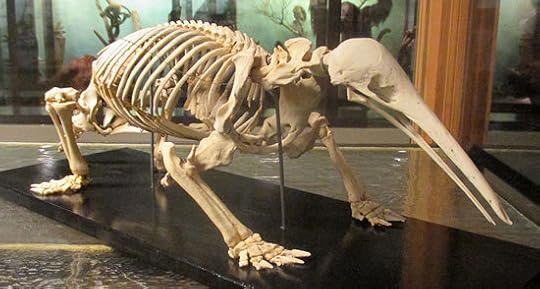 Echidnas lay eggs. That's right, eggs. Like the platypus does. The eggs then incubate and hatch within a pouch, similar to the pouch of a marsupial (kangaroos and such). But unlike all marsupials and placental mammals, the females do not have teats. Instead, the milk oozes out through the mother's skin in the pouch. And then the young lap it up. At least we think the young lap it up--oddly enough, no scientist has ever seen young echidnas lapping up the milk.
Echidnas lay eggs. That's right, eggs. Like the platypus does. The eggs then incubate and hatch within a pouch, similar to the pouch of a marsupial (kangaroos and such). But unlike all marsupials and placental mammals, the females do not have teats. Instead, the milk oozes out through the mother's skin in the pouch. And then the young lap it up. At least we think the young lap it up--oddly enough, no scientist has ever seen young echidnas lapping up the milk.
Echidnas have the lowest average body temperature of any mammals alive today (89º F, 32º C). In fact, when they hibernate, their temp drops to as low as 41º F (5º C). Because of their low body temperature and slow metabolism, echidnas live up to 50 years.
 Baby echidnas are called
puggles
(how perfect is that?). But very few of them have been born (hatched?) in captivity. Only a few dozen have been born in zoos, and in fact it wasn't until 2012 that the first zoo-born parents produced offspring (the baby short-beaked echidna below is one of the offspring).
Baby echidnas are called
puggles
(how perfect is that?). But very few of them have been born (hatched?) in captivity. Only a few dozen have been born in zoos, and in fact it wasn't until 2012 that the first zoo-born parents produced offspring (the baby short-beaked echidna below is one of the offspring).
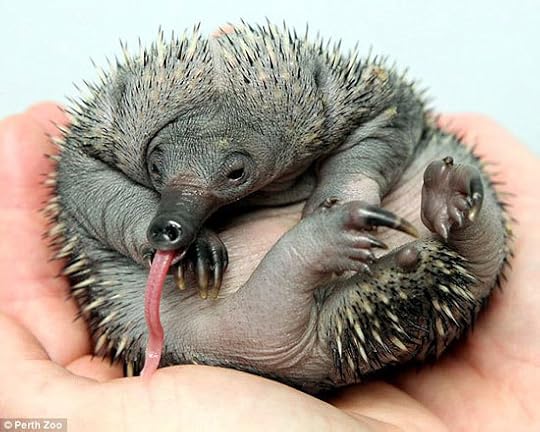 Okay, now for the R-rated portion. Male echidnas have a four-headed penis. Why, you ask? Well, during mating, two of the heads shut down, while the other two enlarge to fit the female's reproductive tract, which happens to have two branches. So why not just have a two-headed penis? Because the males alternate between the two pairs when they mate with more than one female. Why? That's uncertain.
Okay, now for the R-rated portion. Male echidnas have a four-headed penis. Why, you ask? Well, during mating, two of the heads shut down, while the other two enlarge to fit the female's reproductive tract, which happens to have two branches. So why not just have a two-headed penis? Because the males alternate between the two pairs when they mate with more than one female. Why? That's uncertain.
Echidnas have impressive tongues. Their tongues are six inches long, and can dart out of their snouts amazingly fast to slurp up worms and insects.
Check out this awesome video of a feeding echidna from National Geographic.
So, the long-beaked echidna deserves a place in the B.A.H.O.F. (Boss Animal Hall of Fame).
FUN FACT: Most people assume the word boss began being used in place of awesome fairly recently (wasn't it popular in the 1990s?). But actually it was used as an adjective in the Oxford English Dictionary in 1881. So for the last 136 years, it has been a good substitute for awesome.
Photo Credits:
Long-beaked Echidna #1 - Photo by Muse Opiang
Long-beaked echidna being held - Photo by David Gillison
Long-beaked Echidna Skeleton - Science News
Baby captive-born echidna - Perth Zoo
Echidnas belong in the very small group of egg-laying mammals called monotremes. Monotremes are one of the three main groups of mammals (the other two are placental mammals and marsupials). But monotremes includes only five species: three species of long-beaked echidnas, the short-beaked echidna, and the duck-billed platypus. All five of the species live in Australia and New Guinea.
By the way, you may wonder why my featured awesome animals are typically from New Guinea or Australia, when I actually live in the center of North America. Well, I like to feature animals that appear in the novels of the Diffusion Series. And much of the story takes place on the Indonesian side of New Guinea.
 Amazing facts about the Long-beaked Echidna
Amazing facts about the Long-beaked Echidna
Oh my gosh, where to begin! Echidnas are among the strangest of mammals, so there is no shortage of amazing facts.
Let's start with the creature's jaw. Echidna's have no teeth, and their jaw is a single bone. So they do not have the ability to bite or chew. They can only slurp things up through their straw-like snout (they like earthworms and other soft ground invertebrates). Okay, let's take this weird mouth one step further. Not only do they have nothing more than a soft, squishy tube for a mouth, but their snouth also has tiny electro-receptors embedded in it, so they can detect the faint electrical fields created by the worms and other soil critters they eat. Echidnas have between 400 and 2,000 electro-receptors in the tip of their snout. See the long-beaked echidna skull below.
 Echidnas lay eggs. That's right, eggs. Like the platypus does. The eggs then incubate and hatch within a pouch, similar to the pouch of a marsupial (kangaroos and such). But unlike all marsupials and placental mammals, the females do not have teats. Instead, the milk oozes out through the mother's skin in the pouch. And then the young lap it up. At least we think the young lap it up--oddly enough, no scientist has ever seen young echidnas lapping up the milk.
Echidnas lay eggs. That's right, eggs. Like the platypus does. The eggs then incubate and hatch within a pouch, similar to the pouch of a marsupial (kangaroos and such). But unlike all marsupials and placental mammals, the females do not have teats. Instead, the milk oozes out through the mother's skin in the pouch. And then the young lap it up. At least we think the young lap it up--oddly enough, no scientist has ever seen young echidnas lapping up the milk.Echidnas have the lowest average body temperature of any mammals alive today (89º F, 32º C). In fact, when they hibernate, their temp drops to as low as 41º F (5º C). Because of their low body temperature and slow metabolism, echidnas live up to 50 years.
 Baby echidnas are called
puggles
(how perfect is that?). But very few of them have been born (hatched?) in captivity. Only a few dozen have been born in zoos, and in fact it wasn't until 2012 that the first zoo-born parents produced offspring (the baby short-beaked echidna below is one of the offspring).
Baby echidnas are called
puggles
(how perfect is that?). But very few of them have been born (hatched?) in captivity. Only a few dozen have been born in zoos, and in fact it wasn't until 2012 that the first zoo-born parents produced offspring (the baby short-beaked echidna below is one of the offspring). Okay, now for the R-rated portion. Male echidnas have a four-headed penis. Why, you ask? Well, during mating, two of the heads shut down, while the other two enlarge to fit the female's reproductive tract, which happens to have two branches. So why not just have a two-headed penis? Because the males alternate between the two pairs when they mate with more than one female. Why? That's uncertain.
Okay, now for the R-rated portion. Male echidnas have a four-headed penis. Why, you ask? Well, during mating, two of the heads shut down, while the other two enlarge to fit the female's reproductive tract, which happens to have two branches. So why not just have a two-headed penis? Because the males alternate between the two pairs when they mate with more than one female. Why? That's uncertain.Echidnas have impressive tongues. Their tongues are six inches long, and can dart out of their snouts amazingly fast to slurp up worms and insects.
Check out this awesome video of a feeding echidna from National Geographic.
So, the long-beaked echidna deserves a place in the B.A.H.O.F. (Boss Animal Hall of Fame).
FUN FACT: Most people assume the word boss began being used in place of awesome fairly recently (wasn't it popular in the 1990s?). But actually it was used as an adjective in the Oxford English Dictionary in 1881. So for the last 136 years, it has been a good substitute for awesome.
Photo Credits:
Long-beaked Echidna #1 - Photo by Muse Opiang
Long-beaked echidna being held - Photo by David Gillison
Long-beaked Echidna Skeleton - Science News
Baby captive-born echidna - Perth Zoo
Published on August 29, 2017 07:02
August 15, 2017
Awesome Animal - Anhanguera
Today we're going way back in time. These flying reptiles lived from 125 to 115 million years ago. BUT they make a spectacular and terrifying appearance in
Profusion
. And because of that, I have honored them as today's awesome animal. Notice the Anhanguera at the top of Profusion's cover:
 Anhanguera (pronounced Ahn-han-gair-ah) means "old devil" in Portuguese. This creature was one of the flying reptiles in the group commonly called pterosaurs. But it is not nearly as well known as the famous pterodactyl. The Anhanguera's fossils weren't discovered until the 1980s.
Anhanguera (pronounced Ahn-han-gair-ah) means "old devil" in Portuguese. This creature was one of the flying reptiles in the group commonly called pterosaurs. But it is not nearly as well known as the famous pterodactyl. The Anhanguera's fossils weren't discovered until the 1980s.
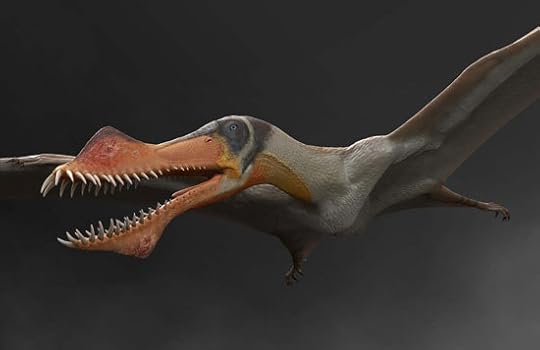 Amazing facts about the Anhanguera
Amazing facts about the Anhanguera
This huge flying reptile had a wingspan of 15 feet (4.5 meters), and weighed up to 50 pounds (22.7 kg). They were larger than any flying creature living today. When standing on the ground it was four feet tall.
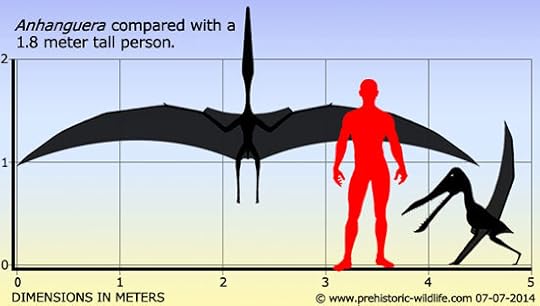 One of the three species of Anhanguera was named after Steven Spielberg. Anhanguera spielbergi was named when a complete fossil was found in Brazil (see the photo below). Apparentlly, the scientist (I cannot find who it was, exactly) was impressed by Spielberg's work (possibly the Jurrasic Park movies?).
One of the three species of Anhanguera was named after Steven Spielberg. Anhanguera spielbergi was named when a complete fossil was found in Brazil (see the photo below). Apparentlly, the scientist (I cannot find who it was, exactly) was impressed by Spielberg's work (possibly the Jurrasic Park movies?).  In movies and artist's drawings, pterosaurs are often shown as having smooth-skinned bodies and wings (instead of feathers and fur). How do we know that's what they looked like? Amazingly, there are a number of well-preserved fossils of pterosaur skin. Paleontologists have found skin impressions from the wing membranes, throat, head-crests and feet. Not only that, but some of them were also covered with fine hairs, called "ptero-fuzz." I love the name, ptero-fuzz!
In movies and artist's drawings, pterosaurs are often shown as having smooth-skinned bodies and wings (instead of feathers and fur). How do we know that's what they looked like? Amazingly, there are a number of well-preserved fossils of pterosaur skin. Paleontologists have found skin impressions from the wing membranes, throat, head-crests and feet. Not only that, but some of them were also covered with fine hairs, called "ptero-fuzz." I love the name, ptero-fuzz!
Due to the structure of their jaws and teeth, it is thought that many of the pterosaurs (including Anhanguera) were fish eaters. In fact, it it likely some of the smaller ones could even dive under the water to catch fish!
The Anhanguera had a beak that was wider at the end than near the head, a shape similar to the bills of today's pelicans. This wider end is thought to have increased their chances of catching fish.
The Anhanguera had weak back legs, which meant that it probably couldn't walk very fast or very gracefully. Check out this animated video. The video is kind of goofy, but it is downright fun. And most of all, it is considered to be one of the best animations of how these creatures used to move.
 So, the Anhanguera pterosaur deserves a place in the J.A.H.O.F. (Jam-up Animal Hall of Fame).
So, the Anhanguera pterosaur deserves a place in the J.A.H.O.F. (Jam-up Animal Hall of Fame).
FUN FACT: Jam-up comes from the word jam, as in close together, or in close contact. Somehow, in America, this gradually became the adjective jam-up, which means perfect. So if you had some really good blackberry jam, you could call it jam-up jam. So, in other words, it's another way to say awesome.
Photo Credits:
Flying Anhanguera #1 - Paul A Ramos
Anhanguera Size Chart - PrehistoricWildlife.com
Coloborhynchus spielbergi - Wikimedia Commons
Anhanguera on the rocks - Daniel Eskridge
 Anhanguera (pronounced Ahn-han-gair-ah) means "old devil" in Portuguese. This creature was one of the flying reptiles in the group commonly called pterosaurs. But it is not nearly as well known as the famous pterodactyl. The Anhanguera's fossils weren't discovered until the 1980s.
Anhanguera (pronounced Ahn-han-gair-ah) means "old devil" in Portuguese. This creature was one of the flying reptiles in the group commonly called pterosaurs. But it is not nearly as well known as the famous pterodactyl. The Anhanguera's fossils weren't discovered until the 1980s. Amazing facts about the Anhanguera
Amazing facts about the Anhanguera
This huge flying reptile had a wingspan of 15 feet (4.5 meters), and weighed up to 50 pounds (22.7 kg). They were larger than any flying creature living today. When standing on the ground it was four feet tall.
 One of the three species of Anhanguera was named after Steven Spielberg. Anhanguera spielbergi was named when a complete fossil was found in Brazil (see the photo below). Apparentlly, the scientist (I cannot find who it was, exactly) was impressed by Spielberg's work (possibly the Jurrasic Park movies?).
One of the three species of Anhanguera was named after Steven Spielberg. Anhanguera spielbergi was named when a complete fossil was found in Brazil (see the photo below). Apparentlly, the scientist (I cannot find who it was, exactly) was impressed by Spielberg's work (possibly the Jurrasic Park movies?).  In movies and artist's drawings, pterosaurs are often shown as having smooth-skinned bodies and wings (instead of feathers and fur). How do we know that's what they looked like? Amazingly, there are a number of well-preserved fossils of pterosaur skin. Paleontologists have found skin impressions from the wing membranes, throat, head-crests and feet. Not only that, but some of them were also covered with fine hairs, called "ptero-fuzz." I love the name, ptero-fuzz!
In movies and artist's drawings, pterosaurs are often shown as having smooth-skinned bodies and wings (instead of feathers and fur). How do we know that's what they looked like? Amazingly, there are a number of well-preserved fossils of pterosaur skin. Paleontologists have found skin impressions from the wing membranes, throat, head-crests and feet. Not only that, but some of them were also covered with fine hairs, called "ptero-fuzz." I love the name, ptero-fuzz!Due to the structure of their jaws and teeth, it is thought that many of the pterosaurs (including Anhanguera) were fish eaters. In fact, it it likely some of the smaller ones could even dive under the water to catch fish!
The Anhanguera had a beak that was wider at the end than near the head, a shape similar to the bills of today's pelicans. This wider end is thought to have increased their chances of catching fish.
The Anhanguera had weak back legs, which meant that it probably couldn't walk very fast or very gracefully. Check out this animated video. The video is kind of goofy, but it is downright fun. And most of all, it is considered to be one of the best animations of how these creatures used to move.
 So, the Anhanguera pterosaur deserves a place in the J.A.H.O.F. (Jam-up Animal Hall of Fame).
So, the Anhanguera pterosaur deserves a place in the J.A.H.O.F. (Jam-up Animal Hall of Fame).FUN FACT: Jam-up comes from the word jam, as in close together, or in close contact. Somehow, in America, this gradually became the adjective jam-up, which means perfect. So if you had some really good blackberry jam, you could call it jam-up jam. So, in other words, it's another way to say awesome.
Photo Credits:
Flying Anhanguera #1 - Paul A Ramos
Anhanguera Size Chart - PrehistoricWildlife.com
Coloborhynchus spielbergi - Wikimedia Commons
Anhanguera on the rocks - Daniel Eskridge
Published on August 15, 2017 05:15



